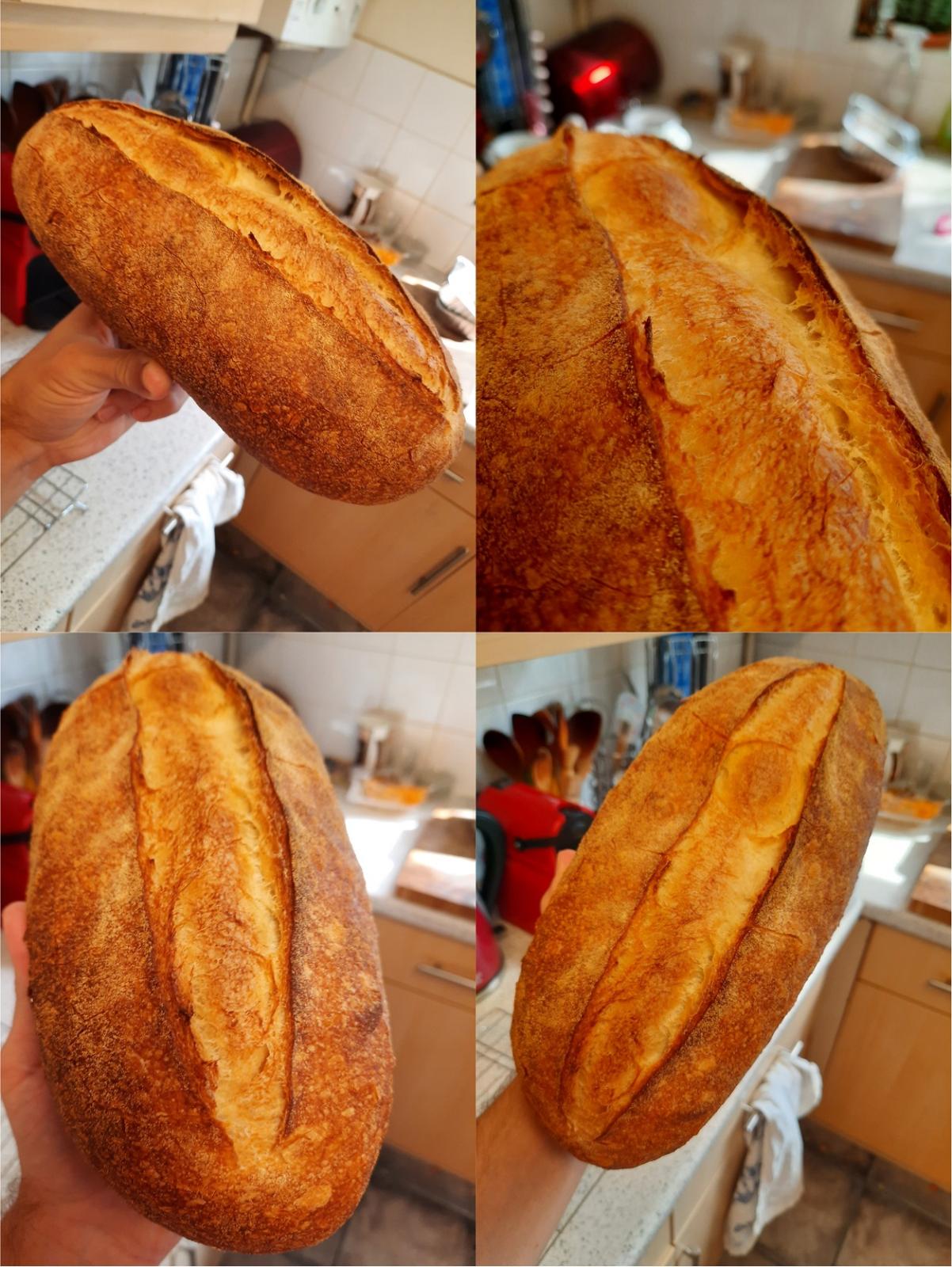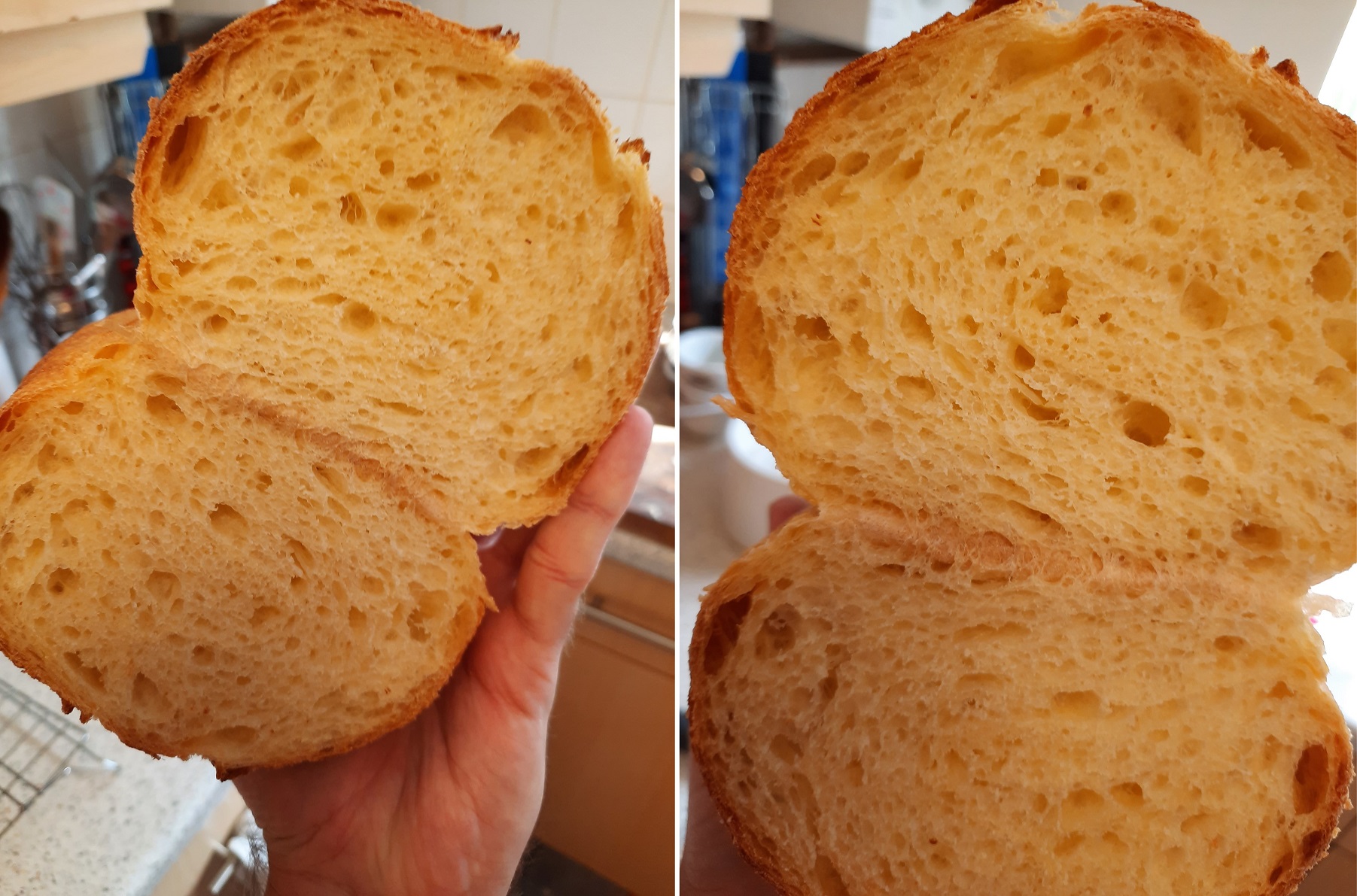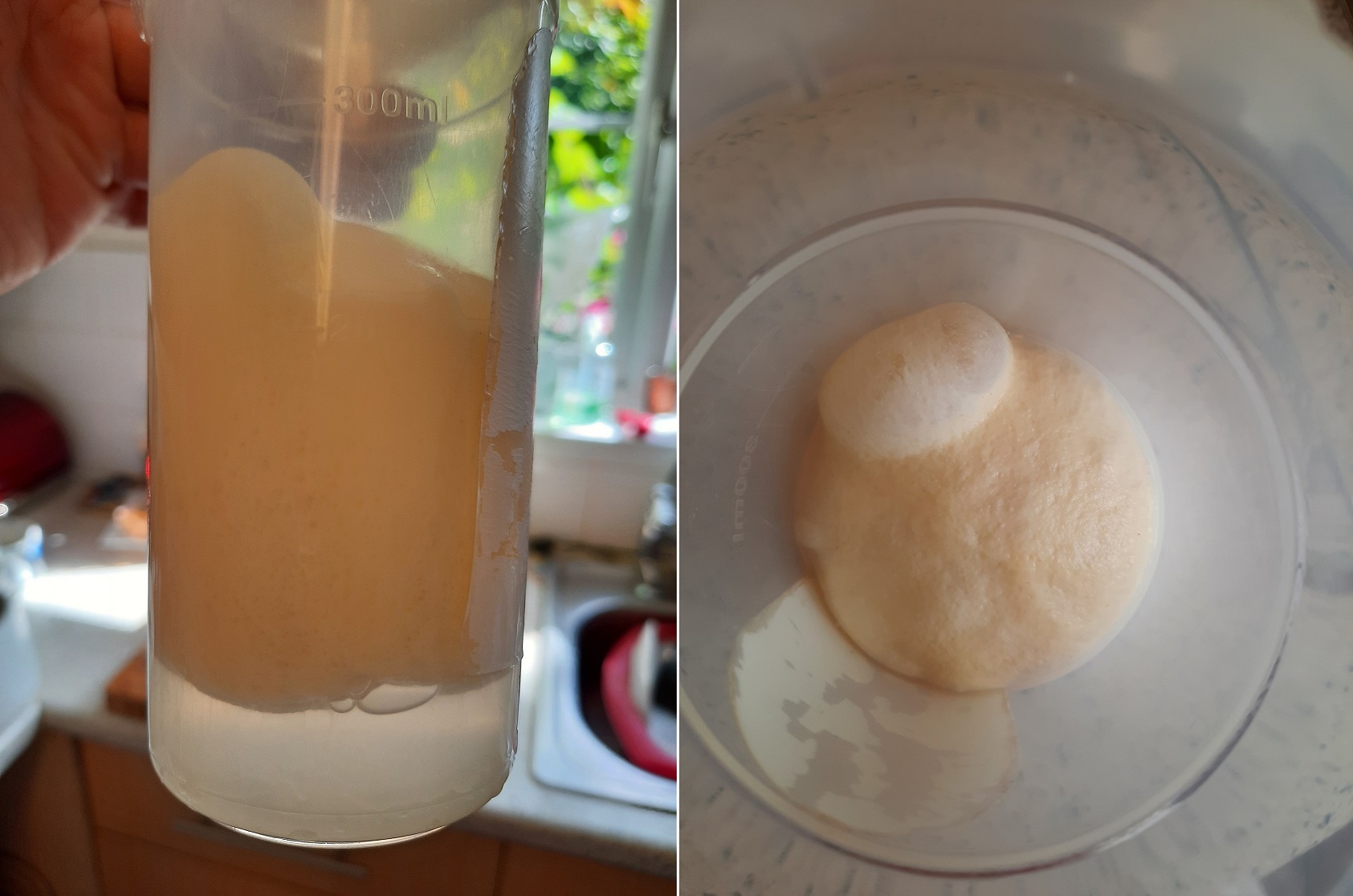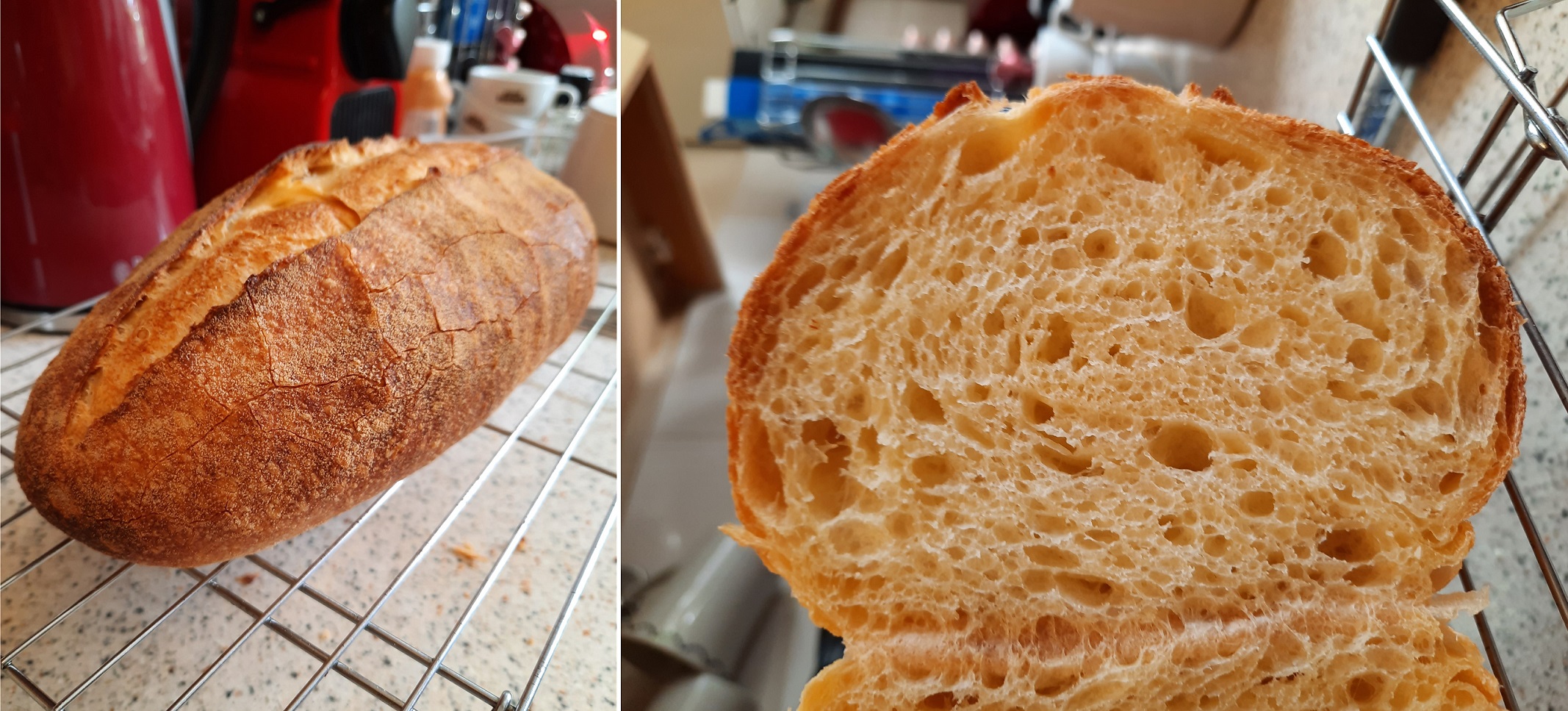
100% Durum wheat loaf, lievitazione naturale

In recent times I have been baking exclusively with durum wheat and the results have got progressively better with each bake. I wanted to explore the typical traditional process whereby an old-dough technique is employed although in real terms I applied the method in my own way.
Continuous old-dough process:
Old-dough (sourdough) (60% hydration and 2% salt).
refreshed 1:1 (old-dough:flour) + enough water to make a firm dough.
Make bread using refreshed old dough at 20%, reserve a piece.
In all cases the reserved old-dough and its refreshed version were stored in water to help speed up fermentation and reduce acid development, this being a common approach with lievito madre storage.
The following durum loaf was made at 80% hydration. A two-hour autolyse at 60% hydration was employed and the final mix was worked to full development.


Old dough in water:

The loaf made following this one, despite all quantities being the same was much softer, something I was aiming for as the process continued. However, adding the last of the water broke the dough - in split, like curdling, thankfully I managed to work it back together with slap and folds. The lesson being that over-hydration with durum wheat is perhaps more of an issue when the gluten is highly resistant.
Thoughts:
Semola rimacinata can be difficult to work with because its gluten is overly tenacious (high P/L values) which means it requires much energy input to work it into a plastic and elastic dough. Using a starter that is on the reductive spectrum really helps to improve the properties whereas acidity makes the situation worse. Durum wheat works best where acid content is very low and the salt in the process positively helps to bring about that condition, improving dough properties.
Update:
-------------------------------
Spreadsheet:
Numerical representation of the method.


Comments
Wow Michael, the crumb you achieved is remarkable. I baked with Semola Rimacinata for the first time recently making a 60% Semola baguette. My crumb wasn’t nearly as good as what you got with your 100% loaf. Interesting that I felt that the dough seemed highly extensible when doing the coil folds and when doing final shaping so I thought that maybe that was a characteristic of the flour, but from what you’re saying it is not. I didn’t do much to develop the dough early on just some Rubaud kneading.
Anyhow, great baking.
Benny
Thanks Benny, the result is in part due to working this dough to full gluten development, something I can't help but always do, otherwise I feel the process is incomplete if I don't. Baking breads with a low density / high specific volume has always been an important goal for me as I find that a lighter texture is more digestible and more pleasurable to eat.
When dough is worked to full development more volume can be achieved and there is a certain level of positive correlation between proof stability and how much the dough was developed during the mixing stage. This being the case I can, and often do let my doughs proof to, at the very least, double and even up to triple in volume before slashing and baking.
The problem with durum wheat and in particular semola rimacinata is that its gluten is highly tenacious, the consequence of this being that it takes of a lot of energy input to work the gluten into an organised macro-polymer.
I recognise some may perceive this flour to be very extensible but that isn't quite the truth of things. The overall strength of durum flour is typically weaker than common wheat but the balance is tipped very firmly in favour of high resistance and poor extensibility.
So why would one perceive greater extensibility? Think of it as a case of underdeveloped gluten where a less developed dough can give better extensibility and so because it is harder to develop this tenacious gluten more of its gluten remains unrealised in doughs that haven't been physically worked to full development.
The length of extensibility ultimately determines the maximal potential volume the dough can reach but durum can often only reach a doubling of volume before it stops growing and this highlights its poor extensibility.
Another way to observe this phenomena is by examining the way a piece of unleavened dough rests after rounding. Truly extensible doughs (P/L < 0.45) will puddle / flatten even at modest hydrations (60%) whereas a tenacious dough might look almost the same after resting.
I did attempt to tackle this subject here.
Cheers,
Michael
Love the crumb! The crust is also spectacular, considering the color, blisters, and especially the cracking. The crust looks thin. How would you describe the bite, chew, and over-all texture?
Question - Elastic characteristics is commonly understood. Please explain “plastic” qualities and characteristics.
When you mentioned the starter was leaning towards the reductive spectrum, is that referring to a young starter as opposed to a matured or over-matured starter, which would be more acidic?
Thanks Danny.
The crust is light / delicate (thin) since the loaf is low density, just as I like and as with all my bakes the crumb is very, very soft, although durum brings a touch of coarseness to the overall texture. Good chew but light and delicate if that makes sense...
Yeah plastic as in malleable, pliable, mouldable. Durum tends to start out clay-like with no elasticity - it tears easily, but by working-out the gluten it becomes more cohesive and supple. Incidentally the quality of plastic relates to its polymeric structure and that is exactly what is created when gluten is developing. In essence; mouldable without breaking.
Regarding the reductive spectrum starter, it's not so simple, an over-mature can be reductive and oxidative but which way that tips is related to a number of other things. This topic requires further investigation...
Cheers,
Michael
A very nice looking loaf Michael - I see you did give that semola a fairly lengthy autolyse!
Lance
Ha, yes in spite of my own precautions. However, some things can be considered:
For me two hours is quite minimal with my approach to an autolyse which applies low hydration & a cool temperature. I might typically do 12hrs with common wheat.
Thanks for kinds words Lance.
Cheers,
Michael
Michael, what is this "reductive" starter process to which you have referred recently? Or is this classified information? ;-)
Lance
Lance, I have added a page on my blog (Research), the first section addresses redox potential. There are two papers, both publicly available which should help provide an insight into this topic.
Michael
Hi Michael, maybe this is not the right post to ask about Lievito Madre, but I need your suggestion. Anyway I have actually change the way I treated my stiff starter a month ago, now immersed in water. My daily routine are 2 refreshments a day, 4 hours at 28c, then 20 hours in the refrigerator around 14-18c with 1:1:0.4 feeding ratio. After the first refreshment, I refreshed the LM and divide the dough into 2 pieces, one part to return to refrigerator and another part to make bread or another refreshment . Since last week My LM for some reasons become very strong and acetic with a little bitter aftertaste. I did bagnetto couple days ago and change my feeding ratio into 1:2:0.8 but the acetic taste and the bitterness is still there. The LM doubled in 1.5 hour with 1:1:0.4 ratio and 2 hours with 1:2:0.8 ratio. What's wrong, does it normal? Can you provide any suggestions? Thank you
Best Regards,
Erick
Hi Erick,
Your daily routine is good and typical. Bitterness is usually a sign of the Madre being too strong. The bitterness being an overt presence of alcohol. I would simply suggest you try the 1:2 ratio refresh again. Perhaps twice in succession. Alternatively you could try using the binding method for the overnight storage since this does a good job at retarding the fermentation and helps shift the acidity towards lactic.
Good luck,
Michael
Hi Michael, thank you for your reply, I guess you were right, the bread smells a little more alcoholic and I just realize it :D. I will try the binding method, thank you for your suggestion :)
Best regards,
Erick
Hi Michael, thanks for this post, lots of great info, as usual. I tried your technique and rather than hijack your thread here I created a new post. I love the work you do with Semola rimacinata. Thanks.
-Brad